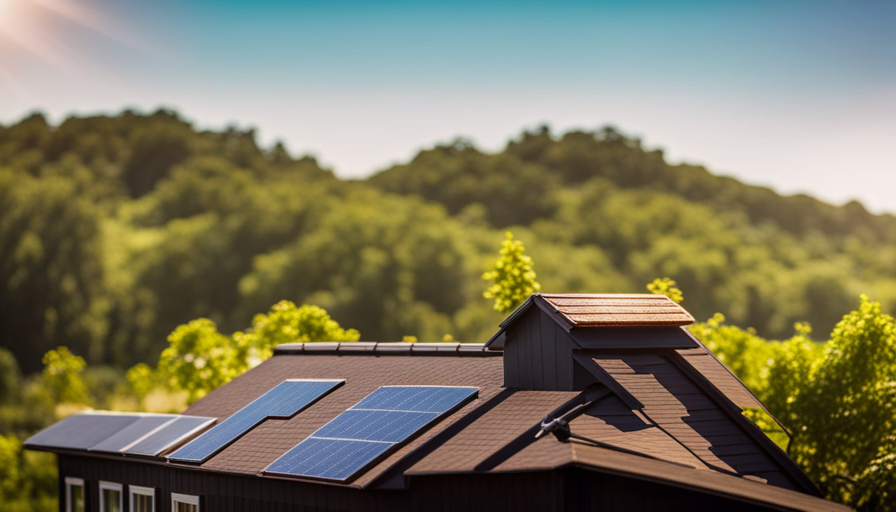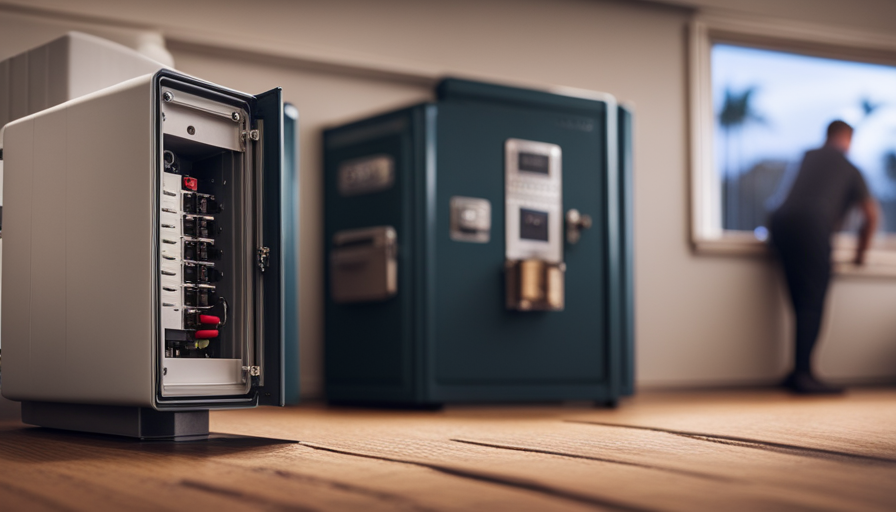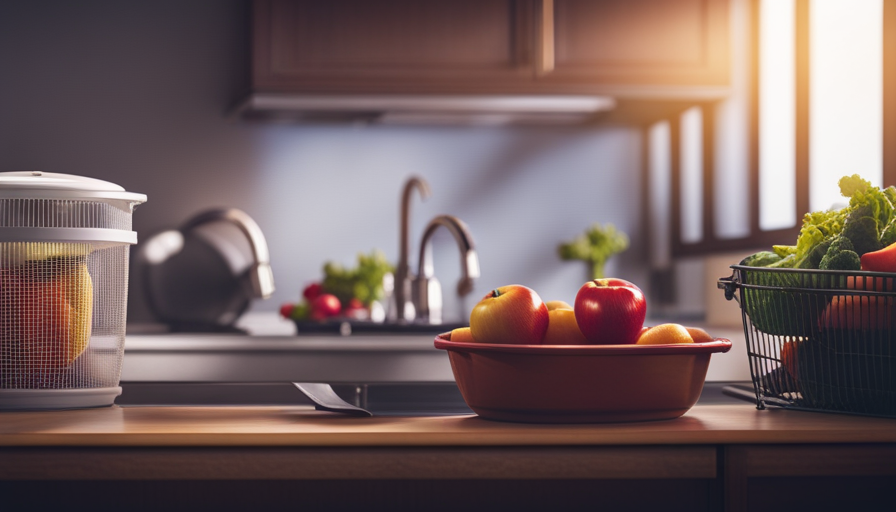Picture a cozy, little house nestled in nature, far from the hustle and bustle of the city. Many enthusiasts of tiny houses, like me, envision this serene setting. Yet, to turn this dream into reality, one must consider practical aspects, such as how to supply **power** to the house. Want to know how to make it happen?
Solar energy is a fantastic option for tiny houses, providing a sustainable and efficient source of power. However, determining how much solar energy is needed to charge a tiny house can be a complex task. Factors such as energy consumption, location, climate, and battery storage capacity all come into play.
In this article, I will guide you through the process of calculating just how much solar energy you need to power your tiny house. So let’s dive in and uncover the secrets to achieving an off-grid, solar-powered life in your cozy abode.
Key Takeaways
- Factors such as energy consumption, location, climate, and battery storage capacity need to be considered when calculating the amount of solar energy needed to charge a tiny house.
- Assessing energy needs involves considering the appliances, electronics, and their power ratings.
- The location and climate impact the availability of sunlight for charging, with higher solar irradiance in certain areas being better for solar energy generation.
- The efficiency of solar panels, their placement, and the capacity of battery storage systems also play a role in determining the amount of solar energy needed.
Assess your energy needs
To accurately determine how much solar energy you’ll need to charge your tiny house, you must assess your energy needs and consider all the appliances and electronics you plan to use on a daily basis.
Start by assessing the solar potential of your location. Determine the amount of sunlight your area receives throughout the year, as this will directly impact the efficiency of your solar panels.
Additionally, estimating the energy efficiency of your appliances and electronics is crucial. Consider using energy-efficient models that consume less power.
By assessing your energy needs and considering these factors, you will have a better understanding of the solar energy required to charge your tiny house.
Moving forward, it’s important to determine your location and climate, which will further influence the solar energy needed for your tiny house.
Determine your location and climate
Based on your location and climate, you can determine the amount of sunlight available for charging your tiny house. Location selection plays a crucial role in maximizing solar energy production. Areas with higher solar irradiance receive more sunlight and are therefore better suited for solar energy generation.
Understanding the impact of climate on solar energy production is also important. Areas with frequent cloudy or overcast conditions may experience reduced solar energy output. Similarly, regions with long winters or shorter daylight hours may have limited sunlight available for charging.
By considering your location and climate, you can assess the feasibility of using solar energy to power your tiny house. Taking these factors into account will help you determine the potential solar energy capacity for your tiny house. This information will be useful when calculating your daily energy consumption needs.
Calculate your daily energy consumption
Determining your daily power usage is essential in understanding your energy needs for your tiny house. To calculate your monthly energy consumption, follow these steps:
- Start by making a list of all the appliances and electronics in your tiny house.
- Determine the power rating (in watts) of each item on your list. This information can usually be found on the appliance itself or in the user manual.
- Estimate the average number of hours each appliance is used per day.
- Multiply the power rating of each appliance by the number of hours it’s used to calculate the daily energy consumption for each item.
- Add up the daily energy consumption for all appliances to get your total daily power usage.
By knowing your daily energy consumption, you can accurately estimate the cost savings of solar energy for your tiny house. The next step is considering the energy efficiency of your appliances to optimize your solar power system.
Consider the energy efficiency of your appliances
Are your appliances energy efficient enough to power your tiny house without draining your solar resources? Can you imagine the impact of using energy-efficient appliances on your energy savings?
When it comes to calculating how much solar energy you need to charge your tiny house, the energy efficiency of your appliances plays a crucial role. Energy-efficient appliances consume less power, allowing you to maximize the use of your solar panel system. By investing in appliances with high energy efficiency ratings, you can significantly reduce the amount of solar energy required to power your tiny house. This not only saves you money in the long run but also ensures that your solar resources are not depleted quickly.
With energy-efficient appliances, you can make the most out of your solar panel efficiency and optimize your energy consumption. Transitioning into the subsequent section about determining the peak sun hours in your area, it is important to understand how solar panel efficiency varies throughout the day.
Determine the peak sun hours in your area
To fully utilize the potential of your solar panel system, it’s crucial to determine the peak sun hours in your area, allowing you to maximize the efficiency of your energy consumption. Peak sun hours refer to the period of the day when sunlight is strong enough to generate the maximum amount of solar energy. It varies depending on the season and geographical location. To get a better understanding, refer to the table below which illustrates the average peak sun hours for different seasons in a hypothetical location:
| Season | Average Peak Sun Hours |
|---|---|
| Spring | 5-6 hours |
| Summer | 7-8 hours |
| Fall | 4-5 hours |
Keep in mind that shading can significantly impact solar energy production. Obstructions such as tall buildings or trees can cast shadows on your solar panels, reducing their efficiency. Understanding peak sun hours and shading will help you determine the most suitable placement for your solar panels. This knowledge will be essential as we move forward to calculate the size of your solar panel system and meet your tiny house’s energy needs.
Calculate the size of your solar panel system
Once you know the peak sun hours in your area and understand how shading can affect solar energy production, it’s time to figure out the ideal size of your solar panel system to power your cozy little home.
To calculate the size of your solar panel system, you need to consider the solar panel efficiency. This refers to the ability of the panels to convert sunlight into electricity. Higher efficiency panels will require fewer panels to generate the same amount of power.
Additionally, you should estimate the installation costs for your solar panel system. This includes the cost of the panels, inverters, mounting equipment, and labor. By considering both the solar panel efficiency and installation costs, you can determine the optimal size of your system.
Once you have this information, you can factor in battery storage capacity to ensure a consistent supply of power for your tiny house.
Factor in battery storage capacity
Factor in battery storage capacity to ensure a consistent and reliable power supply for your cozy home. When calculating the size of your solar panel system, it’s crucial to consider the battery storage capacity that will meet your energy needs. Here are three important aspects to consider when factoring in battery storage capacity:
- Installation options: Determine the type of battery that suits your tiny house. Lithium-ion batteries are popular due to their high energy density and longer lifespan. However, they can be more expensive compared to lead-acid batteries.
- Maintenance requirements: Regular maintenance is essential to maximize the lifespan and efficiency of your battery storage system. This includes monitoring the battery charge levels, checking for any signs of damage or corrosion, and ensuring proper ventilation.
- Cost considerations: Battery storage systems can add to the overall cost of your solar panel setup. It’s important to weigh the upfront cost against the long-term benefits and energy savings.
Now, let’s delve into the next section and explore backup power options to further enhance your energy independence.
Consider backup power options
When thinking about ensuring a reliable and uninterrupted power supply for your cozy home, it’s worth exploring the options available for backup power.
Backup power sources are essential for off-grid living, providing a reliable source of electricity when the sun is not shining or when there is a power outage.
There are various backup power options to consider, such as generators, battery banks, and even connecting to the grid as a backup.
Generators can provide immediate power but are often noisy and require fuel.
Battery banks, on the other hand, store excess solar energy for later use and can be a quiet and clean backup option.
It’s important to consult with a solar energy professional to determine the best backup power solution for your specific needs and to ensure a seamless transition into the subsequent section about consulting with them.
Consult with a solar energy professional
To truly maximize the potential of your cozy home’s power supply, it’s essential to consult with a solar energy professional who can provide expert guidance and tailor a backup power solution to meet your specific needs.
When exploring alternative energy sources for your tiny house, solar power emerges as a cost-effective option. However, determining the exact solar energy needed to charge your tiny house requires careful evaluation. By consulting with a solar energy professional, you can gain insights into the specific requirements of your home and calculate the optimal solar energy capacity needed.
During the consultation, the professional will assess factors such as your energy consumption, available roof space, and sun exposure. They will also consider any additional backup power options that may be necessary to ensure uninterrupted energy supply. Once armed with this information, you can make informed decisions and move forward with confidence.
Transition: Now that we have determined the solar energy requirements for your tiny house, let’s move on to monitoring and adjusting your energy usage.
Monitor and adjust your energy usage
After consulting with a solar energy professional to ensure the most efficient solar panel installation for my tiny house, I’ve now moved on to the next step: monitoring and adjusting my energy usage. This is crucial in order to accurately calculate how much solar energy is needed to charge my tiny house.
By implementing energy-saving tips, such as using energy-efficient appliances and LED lighting, I can significantly reduce my energy consumption. Additionally, I can monitor my energy usage through smart home technology and make adjustments accordingly. This includes turning off unused devices, optimizing heating and cooling settings, and being mindful of water usage.
By actively managing my energy usage, I can ensure that my solar panels are generating enough energy to power my tiny house efficiently and sustainably.
Frequently Asked Questions
How much does a tiny house typically consume in energy on a daily basis?
On a daily basis, a typical tiny house consumes a surprisingly large amount of energy. Understanding its energy consumption patterns is crucial in exploring renewable energy alternatives, such as solar power, to meet its needs efficiently.
What are some energy-efficient appliances that can be used in a tiny house?
Energy efficient appliances are essential for sustainable living in a tiny house. They help minimize energy consumption and maximize efficiency. Some examples include LED lights, low-flow water fixtures, energy star-rated appliances, and smart thermostats.
Are there any backup power options available for a solar-powered tiny house?
Solar-powered tiny houses can have backup power options through solar battery storage. These batteries store excess energy generated by the solar panels, providing a reliable power source during cloudy days or at night.
How long do solar panels typically last before needing to be replaced?
Solar panel lifespan varies depending on several factors, including quality, maintenance, and environmental conditions. On average, solar panels last around 25 to 30 years before needing to be replaced.
How much does it cost to install a solar panel system for a tiny house?
Installing a solar panel system for a tiny house involves several cost factors, such as the size of the system, quality of equipment, and labor fees. The installation process includes mounting panels, connecting components, and ensuring proper electrical connections.
Conclusion
After assessing my energy needs and considering my location and climate, I was able to calculate the daily energy consumption for my tiny house. By factoring in the energy efficiency of my appliances and the peak sun hours in my area, I now have a clear understanding of how much solar energy is needed to power my home.
In addition to that, I have also considered the battery storage capacity and explored backup power options. I consulted with a solar energy professional to ensure optimal efficiency.
Moving forward, I will monitor and adjust my energy usage accordingly.
I’m Theodore, and I love tiny houses. In fact, I’m the author of Tiny House 43, a book about tiny houses that are also tree houses. I think they’re magical places where imaginations can run wild and adventures are just waiting to happen.
While tree houses are often associated with childhood, they can be the perfect adult retreat. They offer a cozy space to relax and unwind, surrounded by nature. And since they’re typically built on stilts or raised platforms, they offer stunning views that traditional homes simply can’t match.
If you’re looking for a unique and romantic getaway, a tree house tiny house might just be the perfect option.










